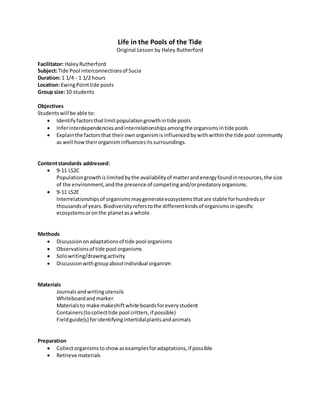
Haley SB OL
- 1. Life in the Pools of the Tide Original Lesson by Haley Rutherford Facilitator: HaleyRutherford Subject:Tide Pool interconnectionsof Sucia Duration: 1 1/4 - 1 1/2 hours Location: EwingPointtide pools Group size:10 students Objectives Studentswill be able to: Identifyfactorsthatlimitpopulationgrowthintide pools Inferinterdependenciesandinterrelationshipsamongthe organismsintide pools Explainthe factorsthat theirownorganismisinfluencedbywithwithinthe tide pool community as well howtheirorganisminfluencesitssurroundings. Contentstandards addressed: 9-11 LS2C Populationgrowthislimitedbythe availabilityof matterandenergyfoundinresources,the size of the environment,andthe presence of competingand/orpredatoryorganisms. 9-11 LS2E Interrelationshipsof organismsmaygenerateecosystemsthatare stable forhundredsor thousandsof years.Biodiversityreferstothe differentkindsof organismsinspecific ecosystemsoronthe planetasa whole. Methods Discussiononadaptationsof tide pool organisms Observationsof tide pool organisms Solowriting/drawingactivity Discussionwithgroupaboutindividual organism Materials Journalsandwritingutensils Whiteboardandmarker Materialsto make makeshiftwhite boardsforeverystudent Containers(tocollecttide pool critters,if possible) Fieldguide(s) foridentifyingintertidalplantsandanimals Preparation Collectorganismstoshowasexamplesforadaptations,if possible Retrieve materials
- 2. Procedure :00 Talk abouttide pool etiquette:(if notpreviouslyexplainedbyAnna- mayaskthemwhat they rememberandremindthemof tipstheydon’tremember) o Watch where youstep.Be careful notto stepon too manybarnaclesandmussels.There isalso seaweedthatisveryslick. o Look closely;observe before doinganything. o Touch gently.Wetyourhandsbefore youtouchany animal,warmdryhands will cause damage to theirdelicate surfaces.Leavethemintheirpool- donottryto take themout, theyneedto stay inthe water.Do not try to pry animalsoff the rocks,mostwill die.If youmove arock to lookunderneath,returnintohow youfoundit. o Use all yoursenses!Listenandsmell! :05 Nowwe will be lookingmicro-scale attide pools! o Talk aboutadaptations o What are some of the adaptationsyouthinkthese organismshave?Thinkaboutwhathelped the organismsurvivedandhowotheranimalsadaptandinteractwitheach otherandtheir surroundings. o These organismshave adaptedtowithstandperiodsof differentwatertemperatures,water salinity,andevennowateratall. o Factors needingtoadaptto: ■ Resistwaterloss Maintainheatbalance Withstandmechanical stress Respire (breathe) duringsubmersionorexposure Feedor absorbnutrients Move (orfor some plantsandanimals,stayputin an optimal place) Withstandsalinityvariation Reproductive adaptations,especiallylifecycle stagesthatrequire certainsubstratesto successfullyattach. Examples: Limpetssuctiontightertorock whenthe tide goesoutto holdwaterin Gunnelscanhide underrocksand stay still toretainwater :15 Discuss:Eventhoughthese crittershave all these adaptations,theystillall have predators.Tide poolshave thrivedforthousandsof years,whyhasn’tone speciestakencontrol overthe wholetide pool?What keepseverypopulationinchecktomaintainbiodiversity? :20 Pass around/displayorganismscollectedincontainers(if possible)orfinda large tide pool tocrowd aroundand pointout variousorganisms.Specifythattheyshouldnottouch,butforthe sake of the lessonIhave captureda fewfor the time beingandIwill returnthempromptly. o What are some thingsyounotice aboutthese organisms?Whatare some adaptationsyou notice andwhydo you thinktheyhave them? o Pointouta fewcool adaptationsforthemtoponder.(Whattheyeat,how theyeat,something that helpsthemsurvive,etc.)
- 3. :30 Tell studentsthattheywill have aboutahalf hour to create theirownorganismsthatlivesinthe intertidal zone!Letthempickatide pool theycan sitat quietlytocreativelyexpressthe critterthey designed.Theywill needtodetail theirorganismforashort activityafterwards. o Needtohave a carefullydetailedexplanationof theirorganism.Canbe labeleddrawingorlistof everyattribute. o Must have predatorand prey/energysource o Needtowrite downintheirjournal how theircreature livesinthisharsh(tous) environment and whatkindof adaptationsithasto live here. o Describe howelse itcaninteractwiththe otherorganismsbesidesthe predator/prey relationships. o Write a story, a poem,drawa picture,etc.showing/depictingthe tide pool theychose withtheir organisminvolved.Label ordetail the environmentalfactorsinteractingwithyourorganism. Have studentspicka perspective tolook throughthe eyes”of whateverorganismtheychoose: Ex: write a storythroughthe eyesof the organismyoudesignedoranothercritters observationof the newadditiontothe neighborhood;draw a picture of yourorganism interactingwithatleastone othercritter,or withinthe whole tidepool :50 Have studentsgetintotheircolorgroupstotalk aboutthe critter theydesigned. Conclusion :65 Have studentsfigure outwithintheirgrouphow theirindividual organismsinteractwith each other. Write downintheirjournalsall the interactions(predator/prey,symbiosis,etc.) andwhose creature it involved. Assessment My evaluationwill be the discussiononadaptationsandonhow theirdesignedcreaturesinteractwith the environment. Extension Get togetherasa big groupto talk aboutindividual organismsandhow theyinteractwitheach other/where theylive inrelationtoothergroups. GlitchPlan If it is raining,we will have instructorsstationedatsafe tide poolstovisitsolessrock-slippingoccurs. We will dothe journalinginashortperiodof time,jottingdownideastheyhave withpersonal whiteboards.Later,we willgive themtimetodraw or write. Risk Management There will be acertifiedWFRwitha firstaidkitduringthe lesson.Give clearrestrictionstowhere the studentscanventure fortheirsit-spotandmake sure theycan still see someone wheretheyare sitting. Remindthemof slipperysurfaces. Background Information: Some of the adaptationsthatallowmaintenance of equilibriadespite these inter-tidalvariablesinclude waysto:
- 4. - Resistwaterloss - Maintainheatbalance - Withstandmechanical stress - Respire (breathe) duringsubmersionorexposure - Feedorabsorb nutrients - Move (or for some plantsandanimals,stayputin an optimal place) - Withstandsalinityvariation - Reproductive adaptations,especiallylifecycle stagesthatrequire certainsubstratesto - successfully attach. In addition,communitiesof organismsinteractamongthemselves,forexample infoodwebs(primary producers,herbivores,carnivores,detritivores),incompetition,parasitism,andsymbioses.These interactionsaddotherstressestowhichorganismsdevelopadaptations.Some of these interactionsand adaptationscanbe discoveredbykeenobservationanddetective work. Whenexamininganorganismindifferentzonesyoucanmake intelligentinferencesaboutwhatstresses the organismissubjectto,and howthe observable featuresof the organismreveal solutionstothese problems.Careful observation,askingquestions,andthinkinglogicallyaboutfairlysimplebut interactingfactorscan leadtodiscoveryof ecological concepts. From: DebDonovan,Biology,WWU